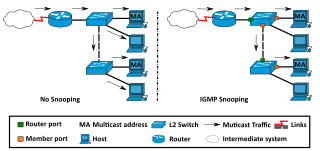
In computer networking, multicast is a type of group communication where data transmission is addressed to a group of destination computers simultaneously. Multicast can be one-to-many or many-to-many distribution. Multicast differs from physical layer point-to-multipoint communication.
The Secure Shell Protocol (SSH) is a cryptographic network protocol for operating network services securely over an unsecured network. Its most notable applications are remote login and command-line execution.
Telnet is a client/server application protocol that provides access to virtual terminals of remote systems on local area networks or the Internet. It is a protocol for bidirectional 8-bit communications. Its main goal was to connect terminal devices and terminal-oriented processes.
A multicast address is a logical identifier for a group of hosts in a computer network that are available to process datagrams or frames intended to be multicast for a designated network service. Multicast addressing can be used in the link layer, such as Ethernet multicast, and at the internet layer for Internet Protocol Version 4 (IPv4) or Version 6 (IPv6) multicast.

Universal Plug and Play (UPnP) is a set of networking protocols on the Internet Protocol (IP) that permits networked devices, such as personal computers, printers, Internet gateways, Wi-Fi access points and mobile devices, to seamlessly discover each other's presence on the network and establish functional network services. UPnP is intended primarily for residential networks without enterprise-class devices.
Remote Authentication Dial-In User Service (RADIUS) is a networking protocol that provides centralized authentication, authorization, and accounting (AAA) management for users who connect and use a network service. RADIUS was developed by Livingston Enterprises in 1991 as an access server authentication and accounting protocol. It was later brought into IEEE 802 and IETF standards.
This page provides an index of articles thought to be Internet or Web related topics.
The Internet Group Management Protocol (IGMP) is a communications protocol used by hosts and adjacent routers on IPv4 networks to establish multicast group memberships. IGMP is an integral part of IP multicast and allows the network to direct multicast transmissions only to hosts that have requested them.
Terminal Access Controller Access-Control System refers to a family of related protocols handling remote authentication and related services for network access control through a centralized server. The original TACACS protocol, which dates back to 1984, was used for communicating with an authentication server, common in older UNIX networks including but not limited to the ARPANET, MILNET and BBNNET. It spawned related protocols:

Anycast is a network addressing and routing methodology in which a single IP address is shared by devices in multiple locations. Routers direct packets addressed to this destination to the location nearest the sender, using their normal decision-making algorithms, typically the lowest number of BGP network hops. Anycast routing is widely used by content delivery networks such as web and name servers, to bring their content closer to end users.
An authentication protocol is a type of computer communications protocol or cryptographic protocol specifically designed for transfer of authentication data between two entities. It allows the receiving entity to authenticate the connecting entity as well as authenticate itself to the connecting entity by declaring the type of information needed for authentication as well as syntax. It is the most important layer of protection needed for secure communication within computer networks.

XORP is an open-source Internet Protocol routing software suite originally designed at the International Computer Science Institute in Berkeley, California. The name is derived from eXtensible Open Router Platform. It supports OSPF, BGP, RIP, PIM, IGMP, OLSR.
Extensible Authentication Protocol (EAP) is an authentication framework frequently used in network and internet connections. It is defined in RFC 3748, which made RFC 2284 obsolete, and is updated by RFC 5247. EAP is an authentication framework for providing the transport and usage of material and parameters generated by EAP methods. There are many methods defined by RFCs, and a number of vendor-specific methods and new proposals exist. EAP is not a wire protocol; instead it only defines the information from the interface and the formats. Each protocol that uses EAP defines a way to encapsulate by the user EAP messages within that protocol's messages.
IP multicast is a method of sending Internet Protocol (IP) datagrams to a group of interested receivers in a single transmission. It is the IP-specific form of multicast and is used for streaming media and other network applications. It uses specially reserved multicast address blocks in IPv4 and IPv6.

Wireless security is the prevention of unauthorized access or damage to computers or data using wireless networks, which include Wi-Fi networks. The term may also refer to the protection of the wireless network itself from adversaries seeking to damage the confidentiality, integrity, or availability of the network. The most common type is Wi-Fi security, which includes Wired Equivalent Privacy (WEP) and Wi-Fi Protected Access (WPA). WEP is an old IEEE 802.11 standard from 1997. It is a notoriously weak security standard: the password it uses can often be cracked in a few minutes with a basic laptop computer and widely available software tools. WEP was superseded in 2003 by WPA, a quick alternative at the time to improve security over WEP. The current standard is WPA2; some hardware cannot support WPA2 without firmware upgrade or replacement. WPA2 uses an encryption device that encrypts the network with a 256-bit key; the longer key length improves security over WEP. Enterprises often enforce security using a certificate-based system to authenticate the connecting device, following the standard 802.11X.
In computing, Microsoft's Windows Vista and Windows Server 2008 introduced in 2007/2008 a new networking stack named Next Generation TCP/IP stack, to improve on the previous stack in several ways. The stack includes native implementation of IPv6, as well as a complete overhaul of IPv4. The new TCP/IP stack uses a new method to store configuration settings that enables more dynamic control and does not require a computer restart after a change in settings. The new stack, implemented as a dual-stack model, depends on a strong host-model and features an infrastructure to enable more modular components that one can dynamically insert and remove.

IGMP snooping is the process of listening to Internet Group Management Protocol (IGMP) network traffic to control delivery of IP multicasts. Network switches with IGMP snooping listen in on the IGMP conversation between hosts and routers and maintain a map of which links need which IP multicast transmission. Multicasts may be filtered from the links which do not need them, conserving bandwidth on those links.
IEEE 802.11s is a wireless local area network (WLAN) standard and an IEEE 802.11 amendment for mesh networking, defining how wireless devices can interconnect to create a wireless LAN mesh network, which may be used for relatively fixed topologies and wireless ad hoc networks. The IEEE 802.11s task group drew upon volunteers from university and industry to provide specifications and possible design solutions for wireless mesh networking. As a standard, the document was iterated and revised many times prior to finalization.
Routing and Remote Access Service (RRAS) is a Microsoft API and server software that makes it possible to create applications to administer the routing and remote access service capabilities of the operating system, to function as a network router. Developers can also use RRAS to implement routing protocols. The RRAS server functionality follows and builds upon the Remote Access Service (RAS) in Windows NT 4.0.
Multicast is what enables a node on a network to address one unit of data to a specific group of receivers. In interactive multicast at the data link or network layer, such as IP multicast, Ethernet multicast or MBMS service over cellular network, receivers may join and leave the group using an interaction channel. Only one copy of the data is sent from the source, and multiple copies are created and then sent to the desired recipient by the network infrastructure nodes. In for example IP multicast, a multicast group is identified by a class D IP address. A host enters or exits a group using IGMP. A message sent via multicast is sent to all nodes on the network, but only the intended nodes accept the multicast frames. Multicasting is useful in situations such as video conferencing and online gaming. Multicast was used originally in LANs, with Ethernet being the best example. A problem with multicast communication is that it is difficult to guarantee that only designated receivers receive the data being sent. This is largely because multicast groups are always changing; users come and go at any time. A solution to the problem of ensuring that only the chosen recipient obtains the data is known as multicast encryption.




